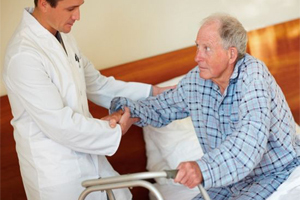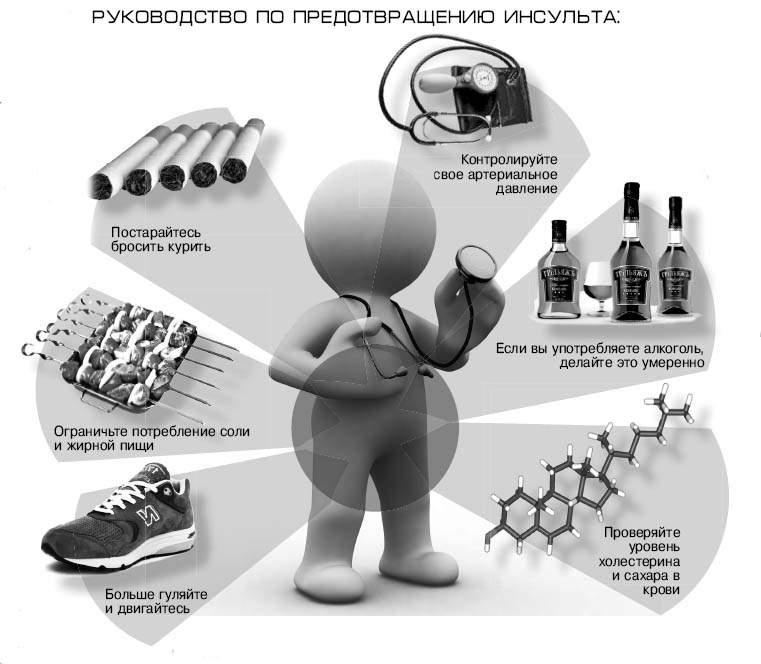 Stroke is a dangerous disease, often leading to disability of the patient or death.
Stroke is a dangerous disease, often leading to disability of the patient or death.
With extensive damage to brain cells due to hemorrhagic or ischemic stroke, a coma appears.
For any form of the disease, the prognosis is such that it takes a long time for rehabilitation to restore the patient after a coma.
Contents
- How to determine the onset of coma?
- Degrees of a coma condition
- What happens to a person in a coma
- Taking care of a patient
- How to get a person out of a coma
- Forecast and chances of survival
- How to recognize the approach of a coma
How to determine the onset of a coma?
Most people wonder how many days the coma continues in a stroke, usually the state of a coma can last from 2 hours to 6-10 days , but sometimes it drags on for months and years.
The onset of coma can be recognized by the following features:
- appearance of silent and incoherent speech;
- characteristic delirium and confusion;
- a few minutes after the main signs of the lack of response to external stimuli;
- occurrence of vomiting, lethargy of the body;
- weak palpation of the pulse, sometimes there is rapid breathing.
Degrees of a coma condition
To simplify differentiation, physicians distinguish the following degrees of coma in strokes:
- 1 degree .It is determined by inhibition or loss of consciousness with preservation of reflexes. This is a weakly expressed lesion of brain cells in stroke and insignificant oppression of the functions of the nervous system. At the same time weakened skin reflexes and increased muscle tone;
- 2 degree .It is diagnosed by a patient falling into a deep sleep, by the lack of reaction to external stimuli, skin reflexes and pain sensations;
- 3 degree .It is caused by an extensive hemorrhage and is determined by the absence of many reflexes, consciousness, the pupils' reaction to light;
- 4 degree .It is not comparable to life, as it is characterized by the absence of spontaneous breathing, a sharp decrease in pressure and hypothermia. There are no reflexes. The patient, who is in such a stage of coma, has almost lost the chance of returning to normal life.
What happens to a person in a coma
In a deep stage of a coma, a patient can not be awakened or reacted to various stimuli. 
He has no reflexes, pupils are narrowed, do not react to light, there is no reaction to painful irritation.
Sometimes there is involuntary urination and defecation.
Only the main reflexes( swallowing, breathing) are retained.
The risk of death is determined by the following indicators:
- coma occurred after a second stroke;
- duration of spasms of limbs 2-3 days;
- the age of the patient is about 70 years;
- no response to sounds, pain and circulation;
- death of brain cells.
The picture can be specified with the help of blood tests, magnetic resonance imaging and computed tomography. With ischemic hemorrhage, there are many chances for a patient to recover.
Care for a patient
Caught in a coma after a stroke of the brain, a person requires constant care. First of all, he needs trained medical staff.
The patient needs to be fed regularly, to provide measures to prevent the occurrence of pressure sores. At a coma the patient feels nothing, is not capable of movements, therefore without taking preventive measures, bedsores always appear.
Patient should be protected from the appearance of infection, maintain physical condition. Medical care includes providing the patient with the necessary vitamins and microelements.
 LFK after stroke is the best method of rehabilitation. We have selected the sets of exercises to restore all the functions of the body.
LFK after stroke is the best method of rehabilitation. We have selected the sets of exercises to restore all the functions of the body. What are the dangers inherent in perinatal encephalopathy - details of treatment and prevention of disease in children.
How to get a person out of a coma
Quitting a coma after a stroke can last a long time. Complete recovery of all functions after awakening a person is impossible and depends on the degree of the disease.
The patient and his relatives should tune in for a long work on his rehabilitation.
In stroke and further coma, some of the brain cells are destroyed. Even with a small proportion of their death, important functions of the body are lost.
Rehabilitation tasks include the transfer of these functions to other parts of the brain. This is possible with the help of daily exercises and exercises, which will gradually become more complicated.
 There may be a memory loss or confused .The victim re-acquainted with all relatives, gradually restoring his habits and skills( he learns to eat and walk, brush his teeth).
There may be a memory loss or confused .The victim re-acquainted with all relatives, gradually restoring his habits and skills( he learns to eat and walk, brush his teeth).
Relatives should facilitate the process of rehabilitation, caring for the patient.
The patient should lead a healthy lifestyle to protect themselves from a second stroke.
First, the patient develops corneal and pharyngeal reflexes, skin reflexes, and muscle reactions. After that speech and consciousness are restored, but delusions, hallucinations and clouding of reason are possible.
Prognosis and chances of survival
Often, a coma is diagnosed when an ambulance arrives and needs urgent resuscitation.
It should also be taken into account that there is a risk of re-hemorrhage in 5% of patients within 3-5 days after a stroke, in 3% of patients after 4 months, therefore, relapse can only be avoided during surgery.
To relieve the symptoms of coma, resuscitation is used, which also includes surgery to quickly and effectively remove the patient from this condition.
In the operation, bleeding is eliminated and an aneurysm clipped, causing symptoms of a stroke.
With a sudden onset of coma, the patient loses consciousness, does not wake up more than 6 hours and the symptoms increase. This can lead to the death of the brain.
To clarify the diagnosis of the disease, an encephalogram is additionally done.
But in some cases, patients can wake up a few months or years after falling into a coma. E
then occurs only in 9% of cases and is associated with the implementation of unexplored brain reserves. The younger the patient, who has fallen into a coma, the more chances there are for his recovery.
How to recognize the approach of a coma
After a brain stroke, a coma often appears, especially in the elderly, but its symptoms are ignored by the patient.
After exiting the unconscious state, a person can recall the following symptoms:
- speech impairment;

- yawning;
- severe dizziness;
- rapid breathing;
- pallor;
- paresthesia with numbness or showing in some parts of the body.
To prevent pathological processes from appearing in the brain cells, one must seriously take care of one's well-being and lead a healthy lifestyle.
You should also remember the signs of the appearance of the disease and, when they appear, seek medical help urgently.
In general, coma is a consequence of the vegetative state. Restoration of the patient depends on the causes, location, severity and extent of brain damage.



